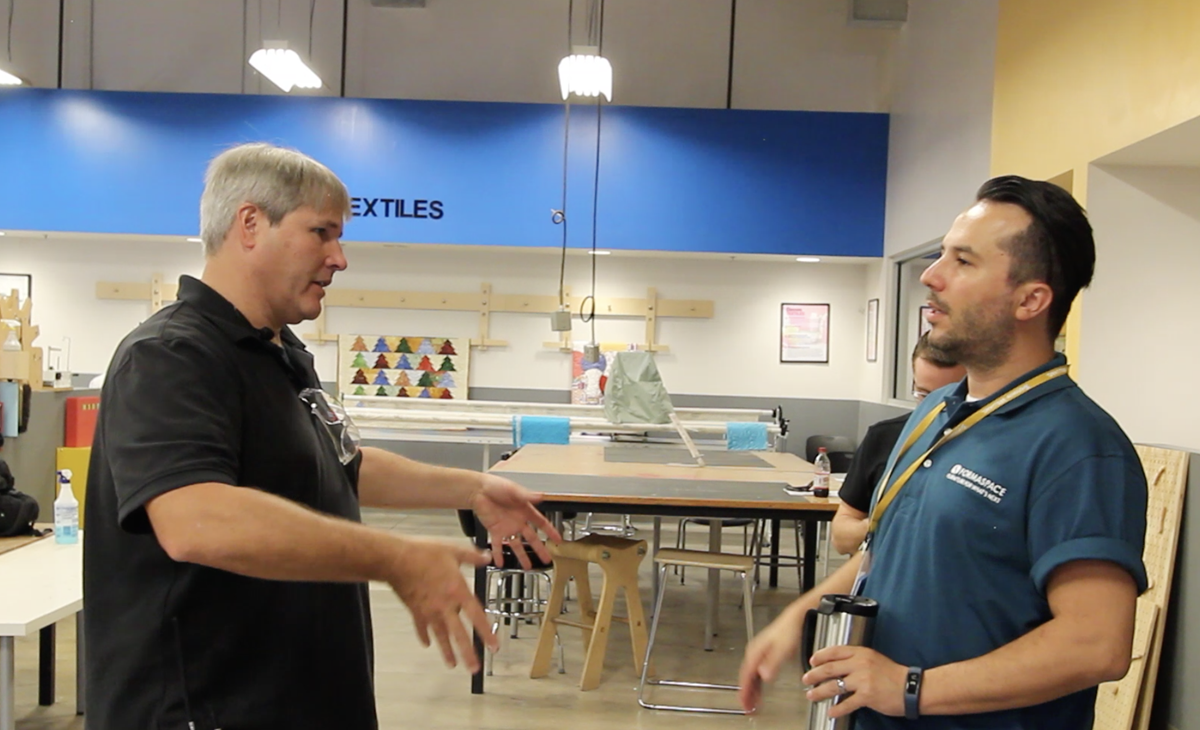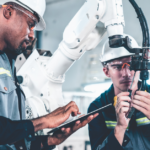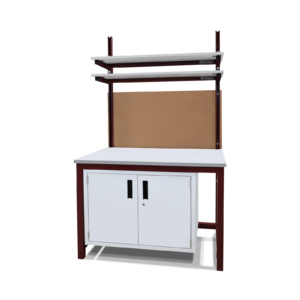TechShop is a fabrication prototyping studio / industrial strength for-profit makerspace featuring a full wood shop, full metal shop, welding lab, electronics bay, textiles studio, 3D printers and laser cutters. Now in their tenth year, TechShop has grown from their first location in the Bay Area to locations around the US and international locations in Japan, France, and Abu Dhabi. We spoke with Mark Emanuel to learn more about the ins and outs of successful makerspaces.
About Mark Emanuel

Mark holds two titles at TechShop:
- Regional Director for Eastern US (locations in Austin, Detroit, Pittsburgh, Washington DC, St. Louis)
- General Manager of the TechShop Austin/Round Rock location
Mark’s prior experience before TechShop:
- Bachelor’s Degree in Mechanical Engineering, Master’s Degree in Engineering Management
- First job working on submarine technology for US NAVY
- Extensive operations background at large Fortune 500 computer manufacturing companies
How Mark came to join TechShop management team:
- Was an enthusiastic TechShop member (customer) before joining the company.
- Started out learning the art of welding.
Q: Thanks for meeting with us Mark. One of the many things that impressed us at TechShop is a quote from your founder, Jim Newton, who says, “We are creating spaces for other people to invent.” Can you elaborate on your mission here at TechShop?
A: The shop is at its core a fabrication prototyping studio and a makerspace. Our job in life is to provide a creative and empowering and engaging environment for individuals from all backgrounds to come in and leverage the tools of innovation to produce the ideas they’ve been dreaming of building.
One of the recurring stories here at TechShop is folks coming in with an idea for something they want to build just for themselves, and they end up launching a business out of it once they realize there is a lot of interest and demand for their idea.
On the other hand, there are also examples of folks coming in with a clear product idea already in mind. They’re here to start a company, and they use our facilities for the initial proof of concept and prototyping stages for their designs.
Q: Have you seen anybody come in here to develop an idea at TechShop and then launch a successful business or product as a result?
A: Absolutely. We’re supporting those entrepreneurs wherever we can. In any given month we’ve got around a dozen startup companies here.
While a big chunk of the Austin startup scene is web development, app development data management, and cyber security, we’re also fortunate to have hardware startups as well. We support this part of the innovation ecosystem, by helping entrepreneurs do their own prototyping and proof of concepts here at TechShop.
For example, we’ve got a gentleman walking around the floor today who is launching a motorcycle accessory business. He came in with a concept and design, used our equipment to prototype it, took that prototype to market, and developed market demand for his product. As a result, he’s been featured in some magazines and at the local biker show. Now he’s gotten retail packaging that he built here in order to launch his product into the market. So he’s in the early stages of growth.
We have other folks that are building IOT (Internet of Things) devices, such as Pretty Smart Homes, which started out building a connected lamp that communicates with your smartphone. They’ve now gone through a development and incubator stage at Texas Venture Labs, during which time they pivoted the product focus toward helping the hearing impaired. The result is a lamp that’s connected to your house – it will signal to the hearing impaired when somebody’s knocking at the front door, when the phone’s ringing, things like that.
These are just a couple of examples, both of which are just pure product hardware devices where folks are coming to us with a concept or idea and a plan – they’re making the proof of concept prototype here.
Q: What are some of the most interesting things you’ve seen created here at TechShop?
A: In our lobby, you’ll see a 12-foot tall custom made iron staff. It’s a very intricately designed, hand-painted, flowing metal form created in our welding lab. The design inspiration came out of an anime series that one of our members is a fan of – and he worked on it, piece-by-piece, for days on end. It was an amazing thing to see come together. So for me, that’s a great example of an interesting project from both an artistic and a fabrication approach.
And then I have a special interest in the projects that entrepreneurs are developing. Recently, we had a company called Ellie Grid who participated in a Pitch con Their project is to create a smart connected pill box that helps elderly folks keep track of their medicines and proper doses. The device has an integrated LED display that makes it as foolproof as you can imagine. They use our 3D printers to crank out version after version with adjustments to form, fit and function.
So I find it incredibly interesting to see this kind of innovation and development taking place here at TechShop – the whole entrepreneurial cycle, from the initial development process to seeing them now on the market testing it and trying to sell it.
Q: Is it just entrepreneurs that come to TechShop or do you also encourage people with less experience who want to learn how to make things?
A: Our goal is to keep extending the reach of the maker community. We can have an impact on communities by encouraging people to get back into the mode of making and creating – it really gives them an outlet to leverage their creative power.
Here in Austin, we have about 750 active members at the moment. In fact, I’ve met some of the Formaspace employees who are members here at TechShop!
Our members range from individuals, like computer programmers, who have never worked in a makerspace (but want to learn how to do something with their own hands) to those who are professionals at their craft who find it easier to use our shop as their production plant (rather than bearing the capital expense of creating their own facility).
We also have folks that come in with a very specific hobby, for example, those that use our textiles studio for sewing and quilting – we’ve got a 10-foot CNC quilter in our studio.
We also have folks that have their own Etsy businesses. So they’re developing their arts and crafts here and selling them on Etsy.
Q: At Formaspace, we’re keenly interested in ideas for creating more productive workspaces, including furniture design and floorplan layouts. What tips and tricks can TechShop offer our readers for creating a highly-efficient makerspace facility?
A: Layouts are an interesting topic.
If you have a membership to one TechShop in the US, you can go to any of the other US shops when you travel. We try to provide a good, consistent look-and-feel across our different locations, both in layouts and in equipment.
We had an interesting story… a startup company taking a road trip from the Bay Area to Texas – to present their product prototype at an SXSW innovation seminar in Austin. They began building their prototype project in our San Francisco shop but didn’t finish everything in time, so they stopped in our San Jose TechShop to make more changes, then stopped again at our Chandler, Arizona TechShop for more updates – all during their drive to Austin. Then they pulled a couple of all-nighters here at the Austin TechShop to get the final product ready to show off at SXSW. So that’s an extreme example of how that consistency pays off!
As I’ve toured through the shops around the country, I’ve observed the shop designs evolving a bit over time. There are some nuances here and there depending on where we were in the purchasing cycle, but by and large, it’s the same kind of gear, so if you are qualified on a machine in Austin you can use the same machine elsewhere.

Some of the other shops had to adapt to the space that they’re in; for example, our San Francisco shop is over two stories, which changes the way the work flow happens. Our DC shop is in a shopping mall in Crystal City, so you have to cross a hallway to go from the metal shop to the main “hub” area. (“Hub” is the TechShop’s term for the central part of each fabrication lab.)
We do want to preserve as much openness as possible in the floorplans. We want the ability to see as much of the shop as possible. So you’ll see in our hub areas, all the walls are half walls. There aren’t any partitions that you can’t see over. You can see from one end of the shop to the other. Same thing for the wood shop and the metal shop: we want it as open as possible.
We group the rooms by the material base. Some of that’s for safety. You don’t want to mix sawdust in with hot metal sparks, you know, things like that. Some of it is for ventilation control.
In particular, you have a significant dust management challenge in the wood shop. When there are half a dozen people in there all making sawdust, we have to make sure we have enough ventilation. So keeping that separate and contained from other areas is important as well.
The wood shop is such a dust-intensive environment, and since dust can travel long distances, it can affect people working on other things. Picture somebody working in an electronics lab, putting together a prototype board; you don’t want the dust encroaching on it. Same thing in the hub, they’re laying down some sub polyurethane on something, you want to give them as clean an environment as we can. And again for safety reasons, you don’t want the sawdust mixed in with machining or welding operations that could produce sparks.
Q: Tell us a little bit more about the “Hub” concept at the heart of each of your functional areas.
A: In the center each of our different shops, we have what we call “hub” tables – so named because this is the center or hub of activity. Most fabrication is done on large (4’x8’) flat surface fabrication tables, with all steel welded frames, which allow people to really do some serious material manipulation on. That’s where most of the stuff happens.
I am a personal opponent to storage on horizontal surfaces, which – especially in a makerspace – encourages stuff to pile up. So most of our desks here don’t have a lower shelf, that way there aren’t places for things to pile up.
We want to place as many of these 4’x8’ work tables in our work areas as possible – so we can have as many members productive as possible. But we also want to make sure there’s enough room around the tables, so they’ve got room to move. We don’t have a central island with a ton of space around it (like some facilities use); instead, each of the tables has a few feet around it – in all directions. Each table has access to drop lines for power and air, so it gives us a little flexibility. We can move the table around a little bit and pull the drop lines out, so it’s not embedded in the concrete. There is enough power and air in across the hub for each person working on one of the hub tables to have what they need to do their fabrication.
The one exception is the layout of the wood shop. There we use more of a central island design; because we need to keep areas clear for transporting and manipulating large pieces of wood (for example 4 x 8 sheets of plywood or long pieces of lumber stock).
Q: Of course we do a lot of fabrication work at Formaspace. What is your impression of our company?
A: I like the idea of the products you are developing and deploying; it’s great.
I also like the way you offer scalability for businesses that are starting up.
And the flexibility you offer to customers – manufacturing fully custom designs for example – is very impressive.
I also like how you are reaching out to the greater community (for example, coming here to TechShop for a visit) – in a way that goes beyond just the core Formaspace furniture business – to talk about how to share knowledge within the community… I think this is great. And I very much appreciate being a part of it. I think Formaspace would be a great partner.
Thank you very much! Likewise, we really enjoy being here at TechShop. We have time for one final question: What do you see as the future of TechShop and makerspaces in general? What is your message for the innovators out there?
A: The biggest message for the future is getting out and building something. Try something. Move beyond the napkin that you’re drawing on. Go create something. Come into TechShop or any other makerspace and get familiar with the tools that are available to you now. Just get started; build something!
As far as TechShop, our goal in life is to continue to deploy more TechShop makerspaces nationwide and internationally. We’ve got a new shop opening in Lille, France soon. So our goal is to keep growing. To keep extending the reach of the maker community, extending the reach of the shop
We can have an impact on communities that get people back into the mode of making and creating, really giving them an outlet to leverage their creative power.
Now beyond that, we’re seeing a lot of activity in schools. I think you guys are seeing that as well. A lot of schools are getting equipment and exposing the children and the students in those schools to the capabilities of the tools that they have, like 3D printers, etc. It’s important to support these educators with the professional development they need.
These educators need to know how to operate that equipment both safely and effectively so they can teach the students to be safe.
And they need to know how to teach the students in their classes how to actually get good results so that they don’t get frustrated right out of the gate.














